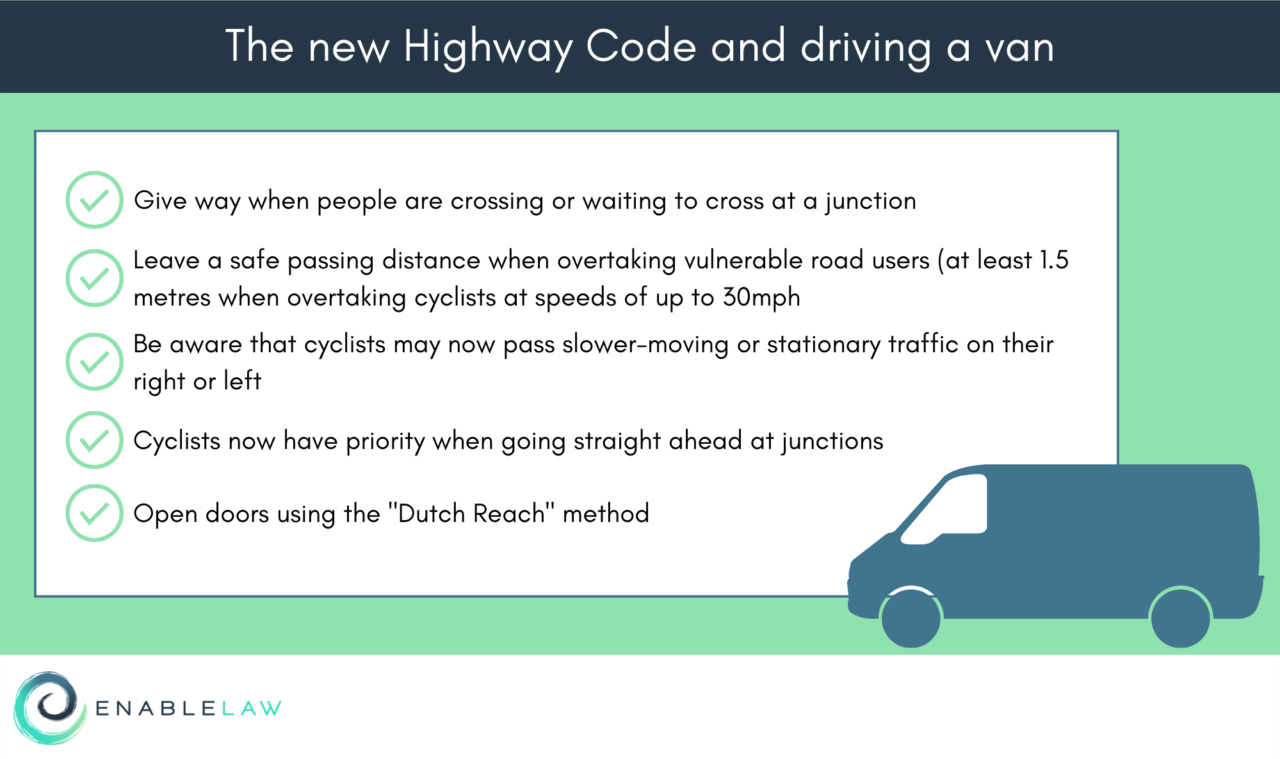
There has been a rapid increase in the number of vans on our roads over the last decade from 3.24 million in 2011 to over 4.6 million by the end of 2020 due to the boom in internet shopping which has been further fuelled by the surge in demand for delivery services during the COVID pandemic.*
According to a study called ‘What kills most on the roads’ published by the Parliamentary Advisory Council for Transport Safety (PACTS) vans and light goods vehicles (LGV’s) had the highest rate of other road user deaths per mile, followed by HGVs. They reported that 64 per cent of those killed by vans and LGV’s in 2019 were vulnerable road users – the majority being pedestrians.
What are the Changes to the Highway Code for van drivers?
Changes to the Highway Code require drivers to take greater responsibility to take care and reduce the danger to others. The principal changes are:
- the need to give way when people are crossing or waiting to cross at a junction.
- to ensure to leave a safe passing distance when overtaking vulnerable road users, leaving at least 1.5 metres (5 feet) when overtaking cyclists at speeds of up to 30mph (and giving them more space when overtaking at higher speeds).
- to be aware that cyclists may now pass slower-moving or stationary traffic on their right or left.
- that cyclists now have priority when going straight ahead at junctions.
- when opening the door to their vehicle it is recommended that a driver should use their hand on the opposite side to the door they are opening in order to look over their shoulder to ensure it is safe to do so (called the ‘Dutch Reach’).
But are van drivers and the fleet van sector ready to deal with these changes?
Concerns have already been expressed by many road safety organisations about the lack of communication from the government about the changes to the Code.
Training and instruction will be crucial but many van drivers are not subject to the same regulation as other occupational drivers (such as HGV drivers) and may not receive any. This is concerning when you bear in mind the significant increase in the number of vans on the roads over the last decade.
It does not help that the majority of new vans entering the market are still not being equipped with the latest safety technology designed to help drivers to drive safely – a decision which seems to be largely driven by cost. In 2019, only 12.8% of new vans were equipped with Autonomous Emergency Braking (AEB), compared to 62% of new cars. Advanced Driver Assistance Systems (ADAS) would help van drivers to comply with the Highway Code changes since they can warn drivers about other road users and help guide drivers when overtaking.
What is the General Safety Regulation 2022?
On 6 July 2022 the General Safety Regulation 2022 will become mandatory in all EU Member States. These regulations make it mandatory for certain safety technologies to be fitted to new cars, vans, trucks and buses. In the case of cars and vans this includes lane-keeping assistance and advanced emergency braking (AEB). Prior to leaving the EU the UK Government had previously been involved in drawing up and supporting these measures. Currently it is being reported in the press that the UK Government could use its new Brexit “freedoms” to ditch the EU regulations. If this happens it would undermine the aims of the Highway Code.
There will no doubt be pressures exerted by various bodies on the UK government to introduce something which is at least similar to the EU regulation and there is a desire to improve vehicle and in particular van safety. Collaboration between Euro NCAP and Thatcham Research has led to the launch of the world’s first Commercial Van Safety Rating which is being supported by leading motor insurers and road safety campaign groups.
Better instruction and training for drivers and better technology in vans would help keep both van drivers as well as other vulnerable road users safe. It would also be consistent with the aims of the new Highway Code.
*Driving for work – a strategic review of risks associated with cars and light vans, implications for policy and practice’ & SMMT’s annual automotive census



















